Building on our work in Texas last year, EO is continuing to explore opportunities for applying best practices in energy development in the Lone Star State. This spring, we were privileged to be guided through the Eagle Ford shale and the Trans-Pecos regions of Texas by Sister Elizabeth Riebschlaeger, a native of Texas, whose knowledge and experience of the regions as well as her indomitable spirit made for an enlightening and informative journey. Sister Riebschlaeger is a Sister of the Sisters of Charity of the Incarnate Word, a member of the Texas Socially Responsible Investment Coalition, which has worked for many years with the Interfaith Center on Corporate Responsibility to raise awareness and coordinate investor engagement and action on responsible shale development.
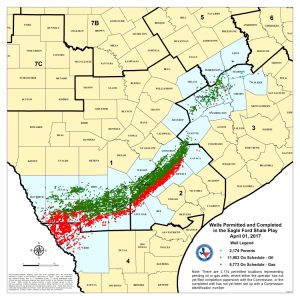
Source: Texas Railroad Commission
The Eagle Ford shale is a geologic formation in southern Texas that produces over 870,000 barrels of oil and more than 4,798 million cubic feet of natural gas per day, according to the Texas Railroad Commission, the state oil and gas regulatory agency. Activity in the region is picking back up following the oil price slump of the last couple of years. In the Eagle Ford, we observed the high density of drilling sites, disposal wells, pipelines and man camps that dot the area. One of the biggest environmental health concerns in the Eagle Ford area is air contamination. A well blowout in May, 2015 in Karnes County, one of the top producing counties in Texas, resulted in evacuations of local residents and, according to a Texas Commission on Environmental Quality report, released more than 860,000 pounds of air contaminants. An air monitor was installed at the Karnes County Courthouse the same year and data from that monitor analyzed by a researcher from the University of Texas at Austin contracted by the TCEQ showed that the hydrocarbon air pollutant levels in Karnes City were by far the highest anywhere in the state.
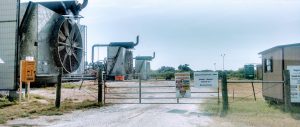
Compressor station in Karnes County (Photo credit: Sr. E. Riebschlaeger)
Furthermore, a recent report by Earthworks that included analysis of air samples taken close to oil and gas facilities in Karnes County found that residents may be chronically exposed to compounds that can cause neurological, respiratory and immunological problems.
Compounding the environmental health impacts of oil and gas development in the area is the “toxic legacy” of open-pit uranium mining carried out between the 1950’s to the 1970’s. Waste pits from the mines can remain toxic for generations. Perhaps this is why the small town of Nordheim in South Texas fought so hard to block the permit for an oil and gas waste site half the size of the town. Nordheim residents sued the Texas Railroad Commission last year, due to concerns of groundwater contamination and the proximity of the proposed site to a school.
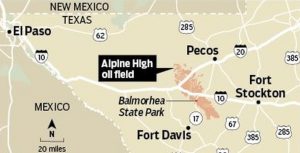
Source: My Statesman, ‘How will West Texas oasis Balmorhea fare in oil play?’, December 22, 2016
In the Trans-Pecos region of West Texas, we visited Marfa, Fort Davis, Toyahvale and Balmorhea via Midland and Odessa, hubs of activity for the oil and gas sector in Texas. The region is home to a controversial cross-border pipeline project as well as to one of the largest shale discoveries in recent years, Alpine High, which was made by Apache Corporation last year. The Alpine High area includes Balmorhea State Park and the San Solomon Springs, an ancient water source fed by a large aquifer system about 400 miles away. The springs are a major tourist attraction and provide a habitat for local wildlife, including two endangered species of fish.

Source: Texas Parks & Wildlife Department
What struck me about the area was how green the surrounding hills and mountains were as we drove to the Davis Mountains State Park, our base for exploring the nearby McDonald Observatory.
The Alpine High oil field is within 30 miles of the Observatory, which has caused concern among some astronomers. We attended a talk by Dr. Bill Wren about the Dark Skies initiative and experienced the dark skies ourselves at one of the observatory’s nighttime constellation tours. Dr. Wren works with regulators, industry associations and operators to reduce light pollution from oil and gas sites and raise awareness about the issue.
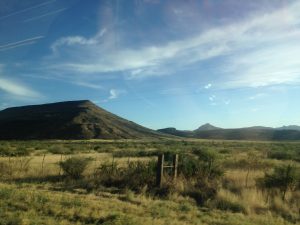
En route to the Davis Mountains State Park (Photo credit: S. Mills)
In addition to threats to the region’s dark skies, other concerns the team heard from local stakeholders included risks related to water demands and impacts on local aquifers, especially those that feed the springs; potential contamination of groundwater resources; air quality from fugitive emissions and flaring; increased traffic and associated impacts, such as dust, road damage and increases in vehicle accidents; transient population influx and corresponding socioeconomic impacts such as increased crime and quality of life impacts; and hazardous incidents and accidents that place increased demands on local area public safety, emergency and fire resources.
The Big Bend Conservation Alliance, a local community organization, has identified a number of potential risks and impacts based on the unique hydrogeology of the region.
One overarching concern was simply the lack of awareness about permits and hearings that would enable communities to better understand the timeline and impacts of development, to raise concerns and to request additional information about the measures operators are taking to reduce potential risks.
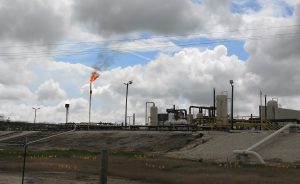
Smoking flare at production site in Karnes County (Photo credit: Sr. E. Riebschlaeger)
In the Trans-Pecos region, there is an opportunity for operators to learn from past experiences in other more established development areas like the Eagle Ford basin, and adopt best practices to minimize negative impacts and maximize benefits for local communities. Apache is already taking steps to in this direction by committing not to drill any wells within Balmorhea State Park or the city itself and by partnering with the University of Texas at Arlington’s Collaborative Laboratory for Environmental Analysis and Remediation (CLEAR), to conduct a baseline water quality study of groundwater and surface water in the area.
We heard from CLEAR scientists, Dr. Zachariah Hildenbrand and Dr. Kevin Schug at a fascinating symposium CLEAR organized during EarthDay Texas in Dallas about Responsible Shale Energy Extraction. The symposium included sessions on potential impacts of and various risk mitigation measures for shale development, including a panel on environmental stewardship in the Alpine High as well as a presentation by Secretary of Energy Rick Perry and a discussion with EPA Administrator, Scott Pruitt.
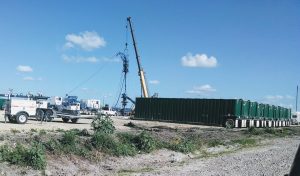
Blowout preventer placement (Photo credit: Sr. E. Riebschlaeger)
While there are many potential risks and impacts of development, emerging technologies and best practices can help to reduce those risks. There is also a need for operators to increase their communication and outreach to local communities as there is an overwhelming desire for more information and transparency. The EO100™ Standard for shale oil and gas operations addresses many of the concerns we heard and we are eager to test out how the Standard works in the field.
As Marilu Hastings, Vice President of the Cynthia and George Mitchell Foundation, said in a recent Op-Ed, “now, more than ever before, we must insist that new development in the Trans-Pecos be done responsibly and with accountability”.



You must be logged in to post a comment.